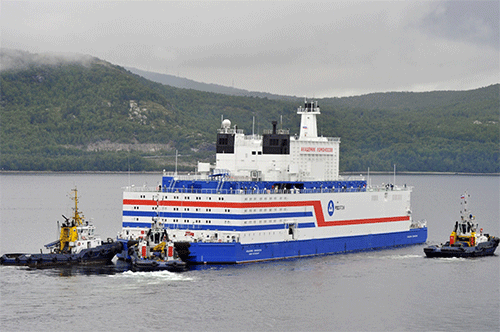Maihapa Ndjavera
Edgar Brandt
ONE of the pioneers of nuclear energy, Russia’s State Atomic Energy Corporation Rosatom (Rosatom), last week stated that if all goes according to plan, they could construct a nuclear power plant in Namibia in the foreseeable future.
“We receive a lot of questions on what we will use uranium for. Currently in Namibia there is only one business which is uranium production, but I think in the future it could be wise to use the local uranium to produce energy,” said Viktor Riedel, Rosatom’s country manager, last week during a media engagement.
Riedel said the nuclear plan for Namibia is not for the short-term and, pending approval, could take up to six years after all consultations with relevant stakeholders to ensure that all parties pull in the same direction.
Rosatom has traditionally been at the forefront of the international nuclear market, including nuclear power plant construction, uranium mining and enrichment, and nuclear fuel fabrication and supply. Rosatom is the mother company of state-owned Russian company, Uranium One, which has created a Namibian subsidiary, Headspring Investment, that is currently leading the charge for a uranium project in the Omaheke region.
Riedel added that Rosatom might consider introducing a floating nuclear power plant in a bid to ensure Namibia’s eventual energy independence. A floating nuclear power plant derives its energy from a nuclear reactor but instead of a stationary complex on land, the power plant consists of a floating structure such as an offshore platform, barge or conventional ship.
“The biggest advantage for Namibia is that there will be security of supply and it will lead to price stability, and also you can sell energy to neighbouring countries,” said Riedel.
The Rosatom manager’s comments come as Namibia still concerningly imports more than 70% of its energy requirements, mainly due to challenges with domestic generation. An analysis by the World Nuclear Association showed Namibia consumed 3 759 GWh of electricity in 2020, while only producing 1 957 GWh.
According to the Bank of Namibia’s quarterly bulletin for December 2023, domestic uranium production increased both on an annual and quarterly basis by 16% and 16.2%, respectively, to 2 286 tonnes during the quarter under consideration.
As such, Namibia is currently the world’s third-largest uranium producer, after Kazakhstan and Canada.
Rosatom’s nuclear advice has been objected to by environmentalists, citing possible contamination from spent fuel, and some local farmers who remain resolute that the risks of the company’s a proposed uranium extraction method in Omaheke outweigh the benefits. Opponents to Rosatom’s extraction method are concerned about dangerous contamination of top rate underground water resources in the area.
World Nuclear Association
Meanwhile, as Namibia debates the pros and cons of using its own uranium to solve one of the biggest obstacles to industrialization targets it set for itself in Vision 2030, the rest of the world is moving ahead full steam.
At the UN Climate Change Conference (COP28) that concluded at the end of last year, more than 20 countries, including the United States, the United Kingdom, Sweden and Canada, pledged to triple their nuclear power capacity by 2025. Even neighbouring South Africa has revealed plans to add 2 500 megawatts of new electricity through nuclear power-generation.
Yet, despite abundant uranium resources, Namibia still stubbornly neglects its own uranium resource blessings to remain a net electricity importer, and thereby continues to rely heavily on purchasing power from its neighbours.
The amount of uranium Namibia has exported since the 1970s could actually produce more than 100 times the country’s current annual electricity consumption. In fact, the World Nuclear Association (WNA) states that just one small nuclear reactor could produce around 186% of Namibia’s electricity demands, while two reactors would provide 372% of the country’s electricity demands.
In addition, the WNA remains adamant that nuclear power is currently significantly safer than fossil fuel production methods, and even safer than renewable energy generation. And, with technological advancements in the construction of nuclear plants, the nuclear option is becoming more attractive as a low-carbon source of energy that can provide a reliable baseload supply of energy.
For many pundits, nuclear is a much better option than renewables such as solar and wind, which are intermittent due to weather dependency. This is because nuclear power, as a continuous domestic low-carbon energy source, offers a stable and uninterrupted source of electricity for the national economy.
“There is no reason why Namibia couldn’t follow in the footsteps of more than 50 other countries who have developed nuclear energy programmes. South Africa has already constructed a nuclear power plant in the region, with two 930 MWe reactors built at the Koeberg nuclear power plant in 1985. That is not, however, to understate the significant preparations required to facilitate the development of nuclear reactors,” the WNA stated late last year in response to New Era queries.
“As in other industries, the design and operation of nuclear power plants aim to minimise the likelihood of accidents, and avoid major human consequences when they occur. Only two major accidents - Chernobyl and Fukushima Daiichi - have occurred in over 18 500 cumulative reactor-years of commercial nuclear power operation in 36 countries. Thanks to new reactor and safety designs, the risk of accidents in nuclear power plants is low and declining. Nuclear has been proven to be one of the safest forms of electricity generation,” the WNA stated.
According to the mines and energy ministry, the reasons Namibia still does not use its own uranium resources to solve its energy import crisis boils down to economic, technological, regulatory, environmental and financial reasons. This, the ministry stated, is coupled with a lack of general demand in the region.
- ebrandt@nepc.com.na


